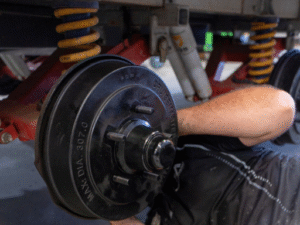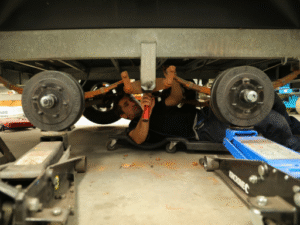The thrill of a caravan adventure often starts long before the road trip begins—but what lies beneath your van can make or break that experience. The chassis and suspension are more than just structural elements—they’re the unsung heroes keeping your caravan safe, stable, and smooth on every journey.
While it’s easy to focus on features like interiors or appliances, neglecting the condition of your chassis and suspension can lead to handling issues, uneven tyre wear, or worse—safety risks while towing. Understanding how these components work and why regular maintenance matters is essential for any caravan owner.
Understanding the Caravan Chassis
The chassis is the backbone of your caravan. It supports the structure, carries the load, and absorbs the stress of every bump and turn on the road. A well-maintained chassis ensures even weight distribution and reliable towing performance.
Rust, cracks, or misalignment can weaken the chassis over time, especially after long trips or exposure to moisture. Ignoring these signs can compromise not only comfort but also structural safety. Regular inspections help catch early wear and prevent long-term damage.
For travellers heading off-road or across rough terrain, the chassis endures even greater stress. Checking weld points, corner joints, and mounting brackets becomes critical, as small fractures can worsen quickly. Reinforcing or upgrading your chassis to suit your towing capacity and load distribution can dramatically improve handling and prevent strain on connected systems like brakes and axles.
Why Suspension Maintenance Matters
Your caravan’s suspension system works closely with the chassis to manage how the van responds to road surfaces. It cushions against potholes, distributes weight, and helps maintain wheel contact on uneven ground. A worn suspension system can lead to excessive swaying, poor braking control, and discomfort for anyone inside.
Leaf springs, shock absorbers, and trailing arms all wear out over time. Replacing or adjusting them before they fail ensures your caravan remains level, steady, and roadworthy—especially on unsealed or corrugated roads.
Regular suspension maintenance also protects your caravan’s interior. When shocks or springs are worn, vibration and impact travel through the frame, damaging cabinetry, fixtures, and fittings. Investing in high-quality components or upgraded systems designed for Australian conditions can greatly enhance ride comfort and reduce long-term repair costs.
The Case for Expert Servicing
While some checks can be done at home, expert caravan servicing goes deeper. Professionals can identify subtle signs of wear, accurately assess alignment issues, and ensure all bolts, bushings, and welds are structurally sound. They also have the tools and experience to handle axle checks, suspension upgrades, or chassis reinforcements when needed.
Neglecting the chassis or suspension can shorten the lifespan of your caravan and increase the risk of roadside breakdowns. Routine servicing by qualified specialists helps prevent those risks and gives you confidence every time you hitch up for a trip.
When Should You Book a Chassis & Suspension Check?
If your caravan is swaying more than usual, sitting unevenly when parked, or showing signs of tyre wear on one side, it’s time for an inspection. Even without symptoms, scheduling regular maintenance before long trips or after extensive travel is a smart move.
Expert caravan service also ensures your setup is suitable for your specific towing needs—especially if you’re carrying heavy loads or going off-road.
Stay Safe. Travel Smooth. Book with the Experts.
At AllBrand Caravan Services, we specialise in thorough caravan chassis and suspension inspections, repairs, and upgrades. Whether you’re preparing for a road trip or want peace of mind between journeys, our team ensures your caravan stays road-ready and reliable.
📞 Call us today: 07 3869 2969
📍 Visit us: 101 Connaught Street, Sandgate QLD 4017
📧 Email: info@allbrandcs.com.au
Keep your caravan rolling smoothly—trust the experts who know what’s beneath the surface.
Useful Resources:


